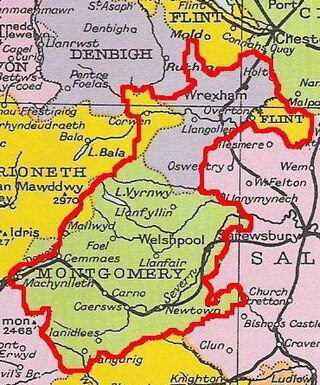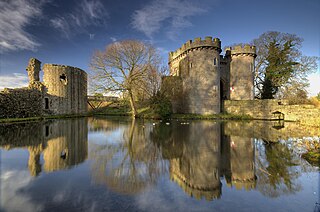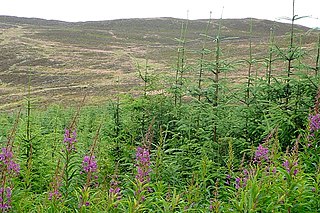Related Research Articles

Deheubarth was a regional name for the realms of south Wales, particularly as opposed to Gwynedd. It is now used as a shorthand for the various realms united under the House of Dinefwr, but that Deheubarth itself was not considered a proper kingdom on the model of Gwynedd, Powys, or Dyfed is shown by its rendering in Latin as dextralis pars or as Britonnes dexterales and not as a named land. In the oldest British writers, Deheubarth was used for all of modern Wales to distinguish it from Hen Ogledd, the northern lands whence Cunedda originated.

The Kingdom of Gwynedd was a Welsh kingdom and a Roman Empire successor state that emerged in sub-Roman Britain in the 5th century during the Anglo-Saxon settlement of Britain.

The Kingdom of Powys was a Welsh successor state, petty kingdom and principality that emerged during the Middle Ages following the end of Roman rule in Britain. It very roughly covered the northern two-thirds of the modern county of Powys and part of today's English West Midlands. More precisely, and based on the Romano-British tribal lands of the Ordovices in the west and the Cornovii in the east, its boundaries originally extended from the Cambrian Mountains in the west to include the modern West Midlands region of England in the east. The fertile river valleys of the Severn and Tern are found here, and this region is referred to in later Welsh literature as "the Paradise of Powys".

Bleddyn ap Cynfyn, sometimes spelled Blethyn, was an 11th-century Welsh king. King Harold Godwinson and Tostig Godwinson installed him and his brother, Rhiwallon, as the co-rulers of Gwynedd on his father's death in 1063, during their destruction of the kingdom of their half-brother, king Gruffydd ap Llywelyn. Bleddyn became king of Powys and co-ruler of the Kingdom of Gwynedd with his brother Rhiwallon from 1063 to 1075. His descendants continued to rule Powys as the House of Mathrafal.

Maredudd ab Owain was a 10th-century king in Wales of the High Middle Ages. A member of the House of Dinefwr, his patrimony was the kingdom of Deheubarth comprising the southern realms of Dyfed, Ceredigion, and Brycheiniog. Upon the death of his father King Owain around AD 988, he also inherited the kingdoms of Gwynedd and Powys, which he had conquered for his father. He was counted among the Kings of the Britons by the Chronicle of the Princes.

Madog ap Maredudd was the last prince of the entire Kingdom of Powys, Wales. He held for a time, the FitzAlan Lordship of Oswestry, family of the Earls of Arundel, of Arundel Castle. His daughter married Lord Rhys, prince of Wales.
Cynddelw Brydydd Mawr, was the court poet of Madog ap Maredudd, Owain Gwynedd, and Dafydd ab Owain Gwynedd, and one of the most prominent Welsh poets of the 12th century.

Llywelyn ap Gruffydd Fychan of Caeo was a wealthy Carmarthenshire landowner who was executed in Llandovery by Henry IV of England in punishment for his support of Owain Glyndŵr's Welsh rebellion.

Tudur Penllyn was a Welsh language poet during the time of the Beirdd yr Uchelwyr, the professional poets of the late Middle Ages.
Elisedd ap Cyngen ap Cadell was a son of Cyngen ap Cadell the last King of Powys.

Whittington Castle is a castle in northern Shropshire, England, owned and managed by the Whittington Castle Preservation Fund. The castle was originally a motte-and-bailey castle, but this was replaced in the 13th century by one with buildings around a courtyard whose exterior wall was the curtain wall of the inner bailey. As a castle of the Welsh Marches, it was built on the border of Wales and England very close to the historic fort of Old Oswestry.

The Royal House of Mathrafal began as a cadet branch of the Welsh Royal House of Dinefwr, taking their name from Mathrafal Castle. They effectively replaced the House of Gwertherion, who had been ruling the Kingdom of Powys since late Roman Britain, through the politically advantageous marriage of an ancestor, Merfyn the Oppressor. King Bleddyn ap Cynfyn would join the resistance of the Anglo-Saxon King Harold Godwinson, against the invasion of William the Conqueror, following the Norman conquest of England. Thereafter, they would struggle with the Plantagenets and the remaining Welsh Royal houses for the control of Wales. Although their fortunes rose and fell over the generations, they are primarily remembered as Kings of Powys and last native Prince of Wales.
According to early modern genealogist Lewys Dwnn, Dafydd ap Dafydd ap Llywelyn was the illegitimate son of Dafydd ap Llywelyn, Prince of Wales and King of Gwynedd between 1240 and 1246. He is considered the ancestor of the Prys or Price of Esgairweddan family, who bore the royal arms of Gwynedd as their own. It is generally considered that this family, in the direct male line descent, died out on the death of Robert Price of Esgairweddan in 1702.

Anwyl of Tywyn are a Welsh family who claim a patrilinear descent from Owain Gwynedd, King of Gwynedd from 1137 to 1170 and a scion of the royal House of Aberffraw. The family motto is: Eryr eryrod Eryri, which translates as "The Eagle of the Eagles of Snowdonia. The family lives in Gwynedd and speak Welsh.

Rhiwaedog is the name of an ancient estate in North Wales, located in the Penllyn forest near Bala, Gwynedd. It gives its name today to two hills, Rhiwaedog-is-Afon and Rhiwaedog-uwch-Afon, meaning "Rhiwaedog below the river" and "Rhiwaedog above the river" respectively. There is also the ancient manor house Plas Rhiwaedog, from which Rhirid Flaidd ruled his demesne.

Gwerful Fychan was a poet during the period of the Welsh Beirdd yr Uchelwyr during the Late Middle Ages. She came from a noble family, her full name in genealogies being given as Gwerful ferch Ieuan Fychan ap Ieuan ap Hywel y Gadair ap Gruffudd ap Madog ap Rhirid Flaidd. She was the heiress of the mansion of Caer-Gai, near Llanuwchllyn, Merioneth. The name Fychan was later anglicised as Vaughan.
Owain ab Edwin of Tegeingl or Owain the Traitor, was lord of the cantref of Tegeingl in north-east Wales at the end of the 11th century. He was the son of Edwin ap Gronw of Tegeingl, a great-great-grandson of Hywel Dda. He sided with the Normans in their failed invasion of North Wales, and in the 1090s attempted to become ruler of Gwynedd.
Sir Gruffydd Fychan ap Iorwerth Goch was a medieval Welsh Knight and Marcher Lord.

Ellis ap Griffith or Elissau ap Gruffudd, was the Baron of Gwyddelwern in Denbighshire, Wales, and the grandnephew of Owen Glendower, Prince of Wales. Following his family defeat during the Glyndwr Rising, his branch inherited the co-representation of the Royal House of Mathrafal, and were immortalized by William Shakespeare in the history play Henry IV. Through his mother Lowrie, he inherited the lordship of his grandfather, Tudor Glendower, and by marriage, the estate of Plas-yn-Yale. By this union, he became the founder of the House of Yale, represented by the Yale family, later known in America as the benefactors of Yale University.
References
- Jones Pierce, Professor Thomas, National Library of Wales , Aberystwyth
- Arch. Camb., IV, v, 197-8, V, viii, 197;
- Dwnn, Lewys, Heraldic Visitations of Wales and part of the Marches, 1613
- Yorke, Philip, The Royal Tribes of Wales, 1799
- H.G. (Hendreg. MSS.) 140, 178.
- Dwnn, Lewys, "Lewys Dwnn and the Parsons" Vol. 2, p. 248-249.